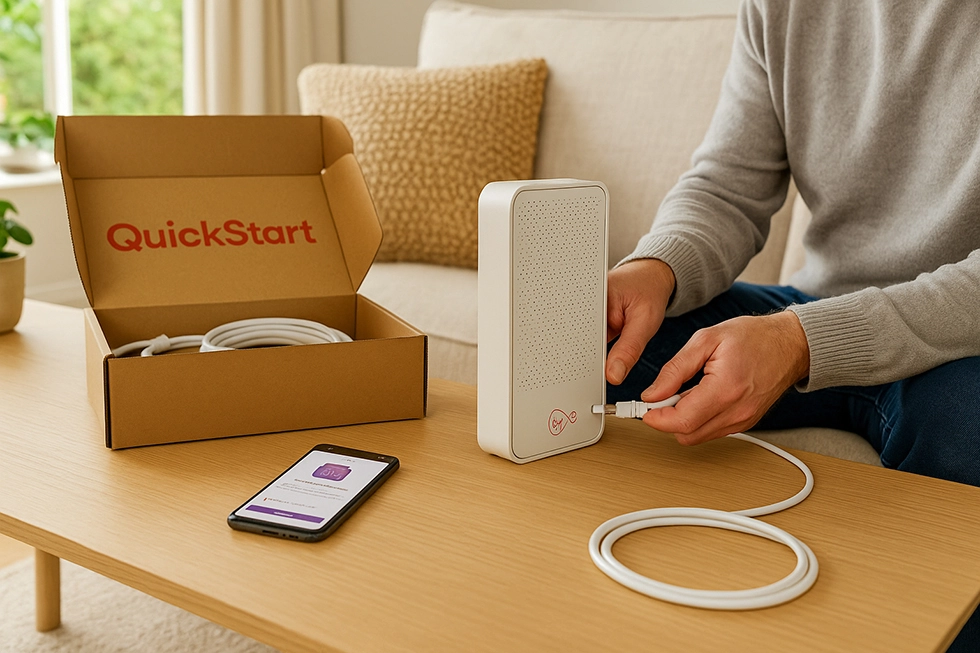BeFibre Router Review UK – Specs and Features
BeFibre’s router range shows how the provider has refreshed its hardware to keep pace with the faster speeds on its fibre network.
Over time, BeFibre has supplied three main router families: the Adtran 854-v6, the Linksys Velop MX4000 series, and the Heights HT-360AXE, which BeFibre brands as the BeHub.
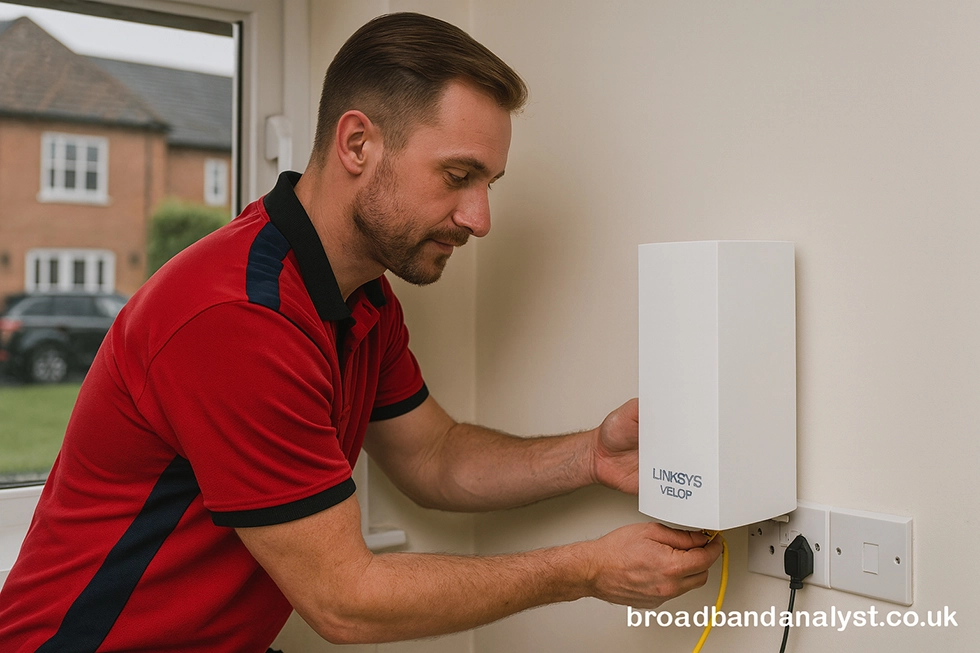
More recently, a new Wi-Fi 7 router has been introduced on selected packages to handle gigabit or multi-gigabit connections without becoming a bottleneck. It can be expanded with mesh units for wider coverage and managed remotely so BeFibre support can step in if problems occur.
BeHub
The BeHub is BeFibre’s main Wi-Fi 6 router and is supplied with most new installations. It is built on the Heights HT-360AXE platform and offers dual-band AX5700 wireless speeds.
The router comes with a 2.5Gb WAN port for the fibre connection, three 1Gb LAN ports for wired devices, and two FXS ports for digital voice. There are also USB 2.0 and 3.0 ports for peripherals.
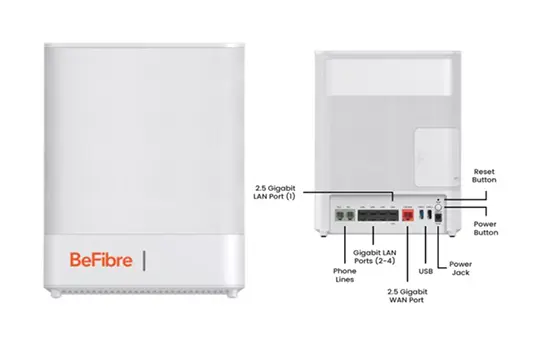
On the wireless side, the BeHub supports EasyMesh Release 2 so customers can add BeMesh extenders and keep one seamless Wi-Fi network around the home. Security is up to date with WPA, WPA2 and WPA3. Remote management is supported with TR-069 and TR-181, so BeFibre engineers can step in quickly if something goes wrong.
BeFibre currently provide the BeHub on their faster packages including Be1000 (900Mb) and Be2300 (2.3Gb). The router’s 2.5Gb WAN port and AX5700 Wi-Fi make it capable of handling these speeds without slowing things down.
BeHub Specifications
- Size/power: 200 × 50 × 255mm, 12V 2.5A
- Wi-Fi standard: Wi-Fi 6 (AX5700, dual-band)
- Wireless: 3×3 2.4GHz (up to ~900Mb), 4×4 5GHz (up to ~4.8Gb)
- WAN: 1 × 2.5GbE port
- LAN: 3 × 1GbE ports
- Voice: 2 × FXS ports
- USB: 1 × USB 2.0, 1 × USB 3.0
- Mesh: EasyMesh Release 2
- Security: WPA, WPA2, WPA3
- Remote support: TR-069 / TR-181
Adtran router
The Adtran 854-v6 was one of the first routers supplied during BeFibre’s initial rollout. It is a Wi-Fi 6 dual-band unit with carrier-grade design, built to support gigabit fibre connections.
The router offers a strong wired setup, with a gigabit WAN port, multiple gigabit LAN ports for wired devices, and dual-band 802.11ax radios. It also includes voice support via FXS ports, allowing digital voice services to run alongside broadband.
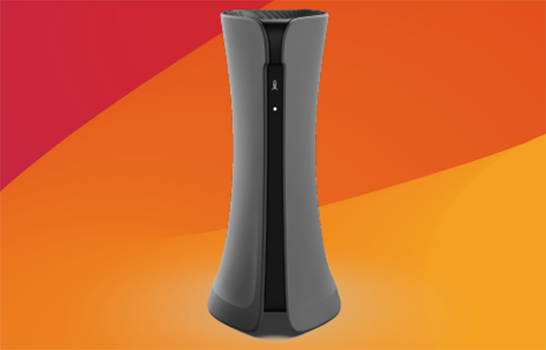
Although BeFibre now supply newer models such as the BeHub, the Adtran 854-v6 is still in use in many homes. BeFibre continue to host support PDFs and quick-start guides for customers using this router.
Adtran 854-v6 Specifications
- Carrier-grade build with IPv6
- Wi-Fi standard: Wi-Fi 6 (802.11ax, dual-band)
- WAN: 1 × 1GbE port
- LAN: 4 × 1GbE ports
- Voice: 2 × FXS ports
- Security: WPA2 / WPA3
- Remote support: TR-069 / TR-181
Linksys Velop MX4000 Series
At the very start of its rollout, BeFibre supplied Linksys Velop MX4000 mesh nodes. These were Wi-Fi 6 modular units designed to be used in pairs or multiples around the home.
The Velop system was managed through the Linksys mobile app and allowed customers to set up whole-home coverage quickly. It was particularly useful for larger houses or properties with multiple floors, where a single router would not have been enough.
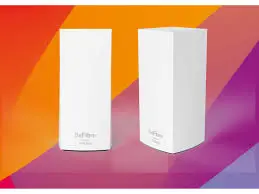
Although BeFibre has since moved on to newer equipment, support articles and setup guides for Velop MX4000 are still available for customers who continue to use the mesh system.
Linksys Velop MX4000 Specifications
- Designed for seamless roaming and whole-home coverage
- Wi-Fi standard: Wi-Fi 6 (802.11ax, dual-band)
- Modular mesh system with multiple nodes
- App-based management (iOS and Android)
- WPA2/WPA3 security
- Gigabit Ethernet ports on each node
BeFibre Wi-Fi 7 router
BeFibre’s latest router option is based on a Heights Wi-Fi 7 platform, with model codes such as HT-6766BE or BEM. It is designed to support the fastest BeFibre packages, including multi-gigabit tiers.
The unit includes a 2.5GbE WAN port for the incoming fibre, a 2.5GbE LAN port for high-speed wired devices, and multiple 1GbE LAN ports for additional connections. It also features FXS ports for digital voice and USB support for peripherals.
As a Wi-Fi 7 router, it brings in advanced features such as Multi-Link Operation (MLO), which allows devices to use multiple bands at once. This reduces latency and improves throughput on supported phones, laptops and consoles.
BeFibre’s Wi-Fi 7 router is now mentioned on their support pages as being available with “eligible packages”. However, the homepage currently promotes a “Free WiFi 7 Router” across all plans, suggesting it is becoming standard equipment for new customers.
BeFibre Wi-Fi 7 router Specifications
- Wi-Fi 7 features: Multi-Link Operation (MLO), higher throughput, reduced latency
- Wi-Fi standard: Wi-Fi 7 (802.11be, dual-band/tri-band)
- WAN: 1 × 2.5GbE
- LAN: 1 × 2.5GbE + multiple 1GbE ports
- Voice: 2 × FXS ports
- USB: 1 × USB 3.0 (with legacy USB 2.0 support)
- Security: WPA3 with backward compatibility
- Remote management: TR-069 / TR-181
Is BeFibre broadband router any good?
Hardware and ports
The BeHub is BeFibre’s main router and is designed as a tall, ventilated desktop unit. It provides all the essential ports for fibre broadband. There is a 2.5GbE WAN port so gigabit and faster packages aren’t held back, three 1GbE LAN ports for wired devices, and two FXS ports for digital voice. USB 2.0 and 3.0 sockets add flexibility for storage or printer sharing. Clear status LEDs indicate power, Internet, and Wi-Fi state, while the rear panel includes a reset switch and labelled power button.
Wireless performance and mesh
As an AX5700 Wi-Fi 6 router, the BeHub uses a 3×3 2.4GHz radio capable of 900Mbps and a 4×4 5GHz radio rated at 4.8Gbps. Features such as band steering, client steering and a single SSID mean devices switch bands automatically. EasyMesh Release 2 allows the BeHub to pair with BeMesh extenders for wider coverage. The ERO1X Pro extender is an AX5400 mesh unit that links wirelessly or via Ethernet. This option is useful in larger homes or properties with thicker walls.
Management and updates
BeFibre configure all routers for remote support. The BeHub uses TR-069 and TR-181 protocols so the provider’s engineers can monitor performance, push updates, or fix issues without a site visit. Self-healing functions restart key processes automatically if a fault is detected. For customers, a local web interface allows changes such as SSID name, Wi-Fi password, or guest network setup. BeFibre also keep setup and support guides online for BeHub, Adtran and Linksys units so older hardware remains supported.
Security
The BeHub covers standard home security. WPA, WPA2 and WPA3 are all supported. NAT and a packet-filtering firewall are switched on by default. Advanced options include DHCP reservations, port forwarding, UPnP, DMZ and dynamic DNS. LED indicators make it simple to see whether an issue is with the Internet line, the router, or the Wi-Fi connection.
Wi-Fi 7 option
BeFibre also offer a Wi-Fi 7 router on eligible multi-gigabit packages. This model adds 2.5GbE WAN and LAN ports, multiple 1GbE ports, and Wi-Fi 7 features such as Multi-Link Operation (MLO). MLO allows devices to connect across bands at once, lowering latency and improving throughput. While most current devices still use Wi-Fi 5 or 6, Wi-Fi 7 support ensures homes are ready for the next generation of phones, laptops and consoles.
Verdict
For customers on 150–500Mbps packages, the BeHub provides more than enough capacity. Real-world performance is strong both in-room and through walls, with dead spots handled easily by BeMesh nodes. On gigabit plans, wired LAN reaches full line speed and wireless remains stable under load. QoS, IGMP snooping and guest Wi-Fi all help keep streaming, IPTV and visitor access running smoothly. Older Adtran and Linksys models still function well, but the BeHub and Wi-Fi 7 units represent BeFibre’s best hardware for current and future packages.
Pros
- Fibre-ready hardware: 2.5 GbE WAN, AX5700 Wi-Fi 6 on BeHub; Wi-Fi 7 router with even faster wireless and dual 2.5 GbE ports.
- Remote diagnostics with local control: support can manage the router, but customers can also log in.
- EasyMesh Release 2 with BeMesh extenders makes coverage simple across the whole home.
- Voice ports included for digital phone service.
- Wi-Fi 7 router now advertised on plans, keeping installs future-proof.
Cons
- BeHub’s three LAN ports are 1 GbE only, so local wired transfers above gigabit require a 2.5 GbE switch or Wi-Fi 7 router.
- Router supplied depends on package, area, and stock. Some customers still have Adtran 854-v6 or Linksys MX4000 nodes.
- Public Wi-Fi 7 documentation is limited to quick guides, so exact specs may vary.
BeFibre Router FAQ
1. What router does BeFibre provide?
BeFibre mainly supplies the Heights HT-360AXE Wi-Fi 6 router, called the BeHub, and now includes a Wi-Fi 7 router on selected plans.
2. Does the BeFibre router support Wi-Fi 6?
Yes, the BeHub is a Wi-Fi 6 (AX5700) router with dual-band radios and strong performance for fibre speeds.
3. What about Wi-Fi 7?
On newer or higher-tier packages, BeFibre now includes a Wi-Fi 7 router designed for multi-gigabit fibre plans.
4. How many Ethernet ports does the BeHub have?
It has three 1 Gigabit LAN ports for wired devices and one 2.5 Gigabit WAN port for the fibre connection.
5. Can I use BeFibre’s router with gigabit broadband?
Yes, the 2.5 GbE WAN port makes sure the router doesn’t slow down gigabit or faster speeds.
6. Does it support digital phone services?
Yes, the BeHub has two FXS ports for BeFibre’s digital voice add-ons.
7. Can I extend coverage with mesh units?
Yes, BeFibre offers BeMesh Wi-Fi 6 extenders that work with the router using EasyMesh Release 2.
8. Is the router easy to set up?
It is plug-and-play. Status lights and clear labels make installation simple, and support can help remotely.
9. Does BeFibre manage the router remotely?
Yes, the router supports TR-069 and TR-181 protocols, so support staff can diagnose and fix issues if needed.
10. Do I still have local access to settings?
Yes, there is a web interface where you can change the Wi-Fi name, password, or create guest networks.
11. What security features are included?
It supports WPA, WPA2 and WPA3, along with NAT, a firewall, and features like port forwarding and DHCP reservations.
12. Is the Wi-Fi strong enough for gaming and streaming?
Yes, the AX5700 Wi-Fi 6 radios provide more than enough speed for HD streaming, gaming and video calls.
13. Does BeFibre still use Linksys routers?
Some older installs used Linksys MX4000 nodes, but most new customers now get the BeHub or Wi-Fi 7 router.
14. What are the main strengths of the BeFibre router?
It is fibre-ready, supports mesh, allows remote support, and is already prepared for Wi-Fi 7 upgrades.
15. Are there any downsides?
The BeHub’s LAN ports are limited to 1 Gbps, so for faster local transfers you may need an extra 2.5 GbE switch.
16. Is the Wi-Fi 7 router worth it?
Yes, it future-proofs your home network and works better with multi-gigabit plans as more devices adopt Wi-Fi 7.
17. Can I use my own router instead of BeFibre’s?
Yes, you can use your own compatible router, though BeFibre recommends their supplied kit for full support and features.
